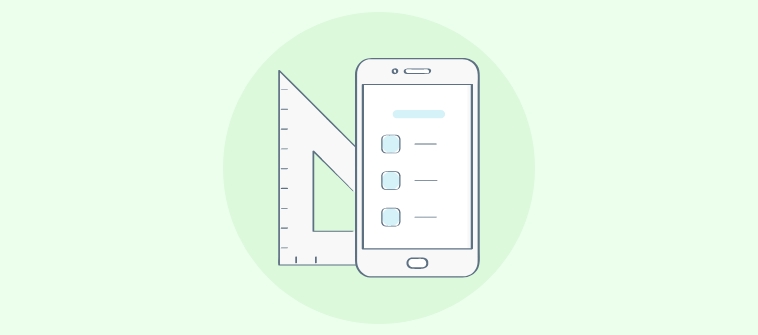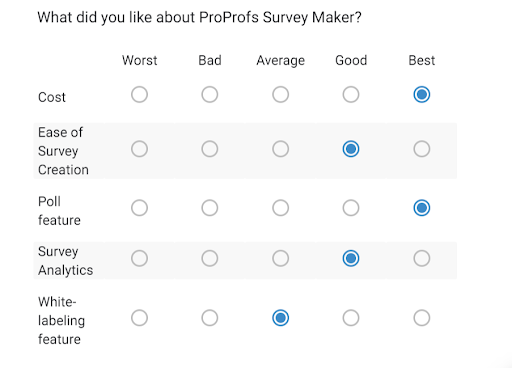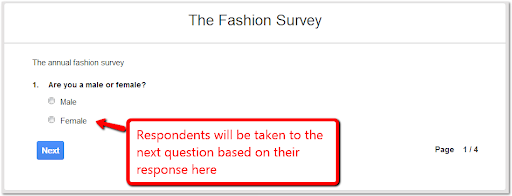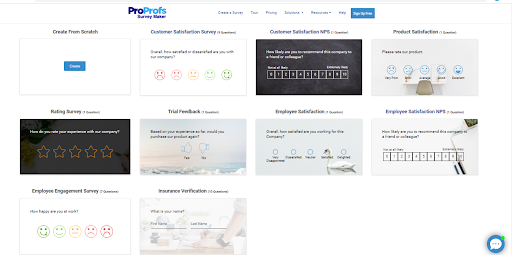
Likert Scale is the perfect means for collecting focused opinions on a particular topic. At times, a simple yes or no could be sufficient when you need to survey customers, employees, or target audiences about their perceptions and opinions. However, when you are required to dig deeper into the respondent’s thoughts, you’ll need a different survey option.
Even though you might not be familiar with the name ‘Likert Scale’, there are possibilities that you may have taken scale surveys in the past. Such surveys make complex opinions simple to understand. And in this blog, we’ve covered everything about the Likert Scale in order for you to capture deep customer insights effectively.
What Is A Likert Scale?
Likert Scale is basically a type of scale used to measure the respondent’s opinion towards a particular subject. The survey takers are given single choice and close-ended questions that allow the brands to collect more detailed information than a yes/no binary answer.
The chief reason for the popularity of the Likert scale is its potential to offer different levels of agreement, quality, and disagreement to the respondents for accurate insights about a subject. Such surveys are usually formed on a scale of 5 or 7 points for expressing the degree of satisfaction, agreement, likelihood, and frequency of using a specific product or service.
Types Of Likert Scale With Examples & Questions
As the Likert Scale definition suggests – these surveys are employed to gauge the level of agreement on a specific topic. For example, on a scale of Strongly Disagree to Agree Strongly. Such scales can be used for a variety of reasons from measuring frequency, quality, likelihood to the satisfaction of a particular aspect of a product/brand.
Likert Scale Surveys are primarily created on a scale of 5 or 7, having the neutral position at the center. However, 4 or 6 scale surveys are also employed when the respondents must provide a clear opinion without being neutral.
7 scale surveys are more commonly used as they offer more choices to the respondents to match their sentiments exactly. Whereas 5 scale surveys are preferred when there are limitations around question length and screen size, especially with the survey modes including SMS or mobile-based survey modes.
Now let’s discuss commonly used Likert Scale examples and types:
(a) 4 Point Likert Scale
Basically, a 4 point Likert scale is a forced scale, which essentially means forcing a respondent to form an opinion, either way. Market researchers use 4 points Likert scale when a user’s opinion is essential without being neutral on a specific topic, such as:
- Satisfied
- Very Satisfied
- Dissatisfied
- Very Dissatisfied
Pros of 4 Point Likert Scale:
- Suitable for the cases when a specific opinion is required.
- Suitable to collect opinions for recently used products/services
Cons of 4 Point Likert Scale:
- It forces the respondent even when they have no opinion
- It can distort the results
Examples of 4 point Likert Scale:
– To measure Frequency
How often do you require Customer Support?
- Never
- Rarely
- Often
- Everytime
– For Agreement
Do you find our product as the best in the market?
- Strongly Disagree
- Disagree
- Agree
- Strongly Agree
– To measure satisfaction
How satisfied are you with the overall experience with the product?
- Satisfied
- Very Satisfied
- Dissatisfied
- Very Dissatisfied
(b) 5 Point Likert Scale
This type of Survey consists of 5 answering options for the respondents among two extreme poles with a neutral answer in the middle. 5 point Likert Scale could be used to measure the satisfaction and agreement levels of the customers.
Pros of 5 Point Likert Scale:
- Easier to understand
- Suitable for a large study/research
- Suitable to produce better data distribution
Cons of 5 Point Likert Scale:
- It sometimes represents inaccurate options
- Unable to address all attitudes
- The outcomes may not be objective
Examples of 5 point Likert Scale:
– For Agreement
How satisfied are you with the quality of our products?
- Satisfied
- Very Satisfied
- Neutral
- Dissatisfied
- Very Dissatisfied
– For Satisfaction
How do you feel about the quality of our customer support?
- Very Poor
- Poor
- Average
- Good
- Excellent
(c) 7 Point Likert Scale
7 Point Likert Scale offers granular insights and tends to be the most accurate among all types of point scales. An upgrade to the 5 Point Likert Scale, this scale provides 7 answer options to a respondent to avoid any confusion.
Pros of 7 Point Likert Scale:
- Most accurate of all Likert Scales
- Easier to use
- Offer true evaluation of the customer’s opinion
Cons of 5 Point Likert Scale:
- The responses may experience bias
Examples of 7 point Likert Scale:
– For Agreement
Spending family holidays at least once a year is necessary?
- Very Strongly Agree
- Strongly Agree
- Agree
- Neither Agree nor Disagree
- Disagree
- Strongly Disagree
- Very Strongly Disagree
– For Satisfaction
What are your satisfaction levels with our customer support?
- Completely Dissatisfied
- Mostly Dissatisfied
- Somewhat Dissatisfied
- Neither Satisfied nor Dissatisfied
- Somewhat Satisfied
- Mostly Satisfied
- Completely Satisfied
When To Use Likert Scale Questionnaire?
The prime reason for the popularity of the Likert style questionnaire over any other type of survey is flexibility. Such surveys are considered as the best way to appropriately gather customer’s sentiments on a wide range of topics, including:
- Measuring the customer interest in an upcoming product or service.
- To measure customer experience with your brand.
- To explore the market demands and customer’s preferences about services such as customer support, communication methods, etc.
However, the usage of the Likert Scale is diverse. Therefore, it has been a promising aspect for successful businesses to gather customers’ opinions for a variety of reasons.
Customer Satisfaction
Measuring customer satisfaction is essential for creating a loyal base and keeping customers happy. Marketing teams make use of a satisfaction survey scale to measure customer service sentiments, which offers customers 5 or 7 options to express their levels of satisfaction.
How Satisfied or Dissatisfied are you with the features of X product?
- Very satisfied
- Somewhat satisfied
- Neither satisfied nor dissatisfied
- Somewhat dissatisfied
- Very dissatisfied
Event Feedback
Companies organize events for several reasons, and to determine it’s a success, it’s more than crucial to collect feedback from the attendees. The collected data reveals whether they have really enjoyed and valued it or not
How informative have you found today’s event?
- Extremely informative
- Very informative
- Somewhat informative
- Not so informative
- Not at all informative
Website Feedback
There are times when people visit your website, consume the available content, stroll through the services pages, and simply leave without making a purchase.
Given that the website visitors are your prime prospects for getting converted into customers, it’s necessary to know how they felt about your website content? What made them leave your website? Will they revisit you?
So, sending a simple scale survey will enable you to know their true perceptions:
How likely are you to return to our website to find information?
- Very likely
- Somewhat likely
- Neither likely nor unlikely
- Somewhat unlikely
- Very unlikely
Customer Information
If you want to scale your products and business to the next level, you should have your finger on the customer’s pulse. Tailor your products and marketing efforts in accordance with their needs by simply asking for their preferences and opinions. A Likert survey question can serve the purpose for you:
How important to you is attractive packaging?
- Extremely important
- Somewhat important
- Neither important nor unimportant
- Somewhat unimportant
- Extremely unimportant
Employee Engagement
When it comes to offering exceptional services to your customers, employee satisfaction should be your top priority. Make your employees feel delighted about being a part of your company, and they can efficiently help you achieve your ever-desired business goals.
Thus, utilize Likert Scale surveys to remain informed about how your employees feel about various aspects of their working environment, including training programs, development processes, employee policies, and more.
I’m satisfied with the investment the company makes in my career growth.
-
- Strongly agree
- Agree
- Neither agree nor disagree
- Disagree
- Strongly disagree
How To Write Likert Scale Survey Questions?
Just knowing about the purpose of the Likert scale won’t help you. For Likert Scale surveys to bring plausible outcomes, you must also be proficient in crafting professional Likert Scale questions.
Several factors affect the final results, and we are here to guide you through.
Try To Be As Specific As Possible
While planning out the best Likert Surveys and question types, make sure to be as detailed as possible. For example, clearly mention the product name or specification you want to collect insights about.
While using multi-products and services, respondents may get confused about which product you are talking about. Hence, it’s essential to craft the Likert questions accurately with all supporting information and images wherever possible.
Use Clear Labels
For the respondents to quickly and accurately fill out survey responses, strive to make questions crisp and clear. You cannot just write scale numbers 1-5 or 1-7 without accurately labeling which side is positive or which one is negative.

Hence, try to use clear terms so that the users can precisely select their answers. Also, you can add a short explanatory text if you think the question topic may be confusing and respondents may find it difficult to understand.
Decide The Response Scale
While creating Likert Scale Surveys, contemplate upon the correct response scale to gather accurate research data. You must be selective as the scale should not be complex and confusing. Some of the popularly used scales are: Agree – Disagree, Helpful – Not Helpful, Excellent – Poor, Satisfied – Dissatisfied, Always – Never, etc.
However, being popular doesn’t necessarily mean it is relevant. Make sure the categories used are valid and useful. For example, you’ve chosen Never – Seldom – Sometimes – Often – Always, when you want to know how often the customers prefer online shopping. But is there a potential difference between Seldom and Sometimes? No! Hence, using such ambiguous response terms will confuse the respondents and the survey response data will lack accuracy.
Use Skip Logic
Use skip logic or conditional branching when you need to present relevant questions to the respondents based on their previous answers. This helps the businesses to create relevant Likert Scale surveys that could be completed quickly – enhancing the overall completion and response rates.

Therefore, conditional branching assists in guiding the respondents in a logical manner and collecting reliable data to present actionable conclusions.
Be Creative
You cannot just sound like a robot while collecting user data. Instead, you should create engaging surveys that will urge respondents to complete the survey responses and motivate them to fill accurate responses. Use survey tools like ProProfs Survey Maker, which helps you customize the labels to create beautiful surveys.

Make use of the extensive library of ready-made survey templates for creating surveys for your business needs.
FREE. All Features. FOREVER!
Try our Forever FREE account with all premium features!
Analyzing Data From The Likert Scale
Now that you have successfully created Likert Scale surveys and got your customer feedback, it’s time to analyze what you’ve got. You’ll certainly need a team to analyze the survey results and determine the key respondent’s behavior to confirm whether you’ve achieved survey goals or not.
However, you must make sure which type of data are you dealing with i.e. Ordinal data or Interval data, before analyzing Likert Scale surveys.
Ordinal Data is the collected data from each Likert question. Every item has either a lower or higher rank than the others but there isn’t a uniform difference between them. For example, there is no certainty that the difference between “very bad” and “bad” is exactly the same as the difference between “good” and “excellent”.
Whereas Interval Data is the data collected from an overall Likert Scale. Interval scales have a defined order and the difference between each rank is evenly distributed. For example, a Likert Scale 1-10 has a difference between 3 and 5 same as the difference between 7 and 9.
Descriptive Statistics
Data collected by the Likert scale surveys could be easily summarized by using descriptive statistics in numerics or visual forms. However, each question can also be individually analyzed for deeper insights.
For Ordinal Data: To measure the overall score of the sample, you need to find the mode or the most common answer for each question. Whereas for a visual representation of the frequency, you can create a bar chart of each item choice.
For Interval Data: Add up all the scores for each question to find out the total score for each respondent. You need to either find out the mean, average score, standard deviation, or spread of the scores for your sample.
Inferential Statistics
Inferential Statistics is usually employed to find out correlations between different responses or patterns in the complete sample. At the most, this method leaves no other option than to acquire data from samples. With the inferential statistics method, you will end up using random sampling methods.
Needless to say, that sample size is always smaller than the actual size of the audience. Hence, there will always be a part of the audience that gets ignored and causes a Sampling Error, which is nothing but the difference between the actual audience values and the measured sample values.
However, there are other ways to analyze survey data, as well. The most feasible is to calculate a median instead of a mean. For this, you’ll need to arrange the responses in chronological order and analyze the responses that fall at the midpoint.
Let’s assume you have 100 responses, the midpoint would be the 50th response. So, a median that’s 3 or greater than 3 shows that most respondents agreed, while a point below 3 will indicate that most respondents disagreed.
Advantages Of Likert Scale Surveys
Since its inception by Rensis Likert, such scale surveys are considered as the most effective way to measure customer perception towards a brand or a product. The Likert-Type scale enables you to understand the feedback in a comparatively better way because it offers various degrees of responses.
- Easier Implementation
Being effective doesn’t necessarily mean being complex. Likert Scale surveys prove the same. These surveys are easier to implement and are used universally – making it the most familiar means for the customers to share their experiences, attitude, and behavior towards a particular brand, product, or service.
Also, for businesses, the Likert Scale is one of the most effective means of measuring the responses that are easy to quantify and can be calculated via mathematical analysis.
- Easy Answering Options
Likert Surveys do not force the respondents to make a concrete choice. Rather than relying on binary Yes/No answers, Likert Scale Surveys offer various degrees of agreement so that the survey takers could accurately share their opinion on each Likert item.
- Better Response Rate
Of all the available survey methods, the Likert Scale yields a better survey response rate. There are several factors that contribute to attaining such high numbers, however, the chief reason being the ease of selecting an appropriate degree of agreement, frequency, likelihood among the given choices. Likert Scale offers different choices for the respondents that reflect their sentiments – resulting in a higher survey response rate than other methods.
- Suitable For Focused Surveys
Likert Scale Surveys are the way to go when you are gathering customer perception around a single topic. You could simply add a series of follow-up Likert-type questions on a specific topic which ultimately makes the reporting and analysis easier.
For instance, while measuring the data for new product customers, you could craft the survey as:
“How satisfied or dissatisfied are you with the X product?”
Followed by:
How satisfied or dissatisfied are you with the level of information provided via the knowledge base?
How satisfied or dissatisfied are you with the sales agent interaction?
How satisfied or dissatisfied are you with the product experience?
This way, you can add up more relevant questions on the same topic and ultimately examine the data in the end to determine the overall satisfaction or dissatisfaction of the customers with your newly launched product.
- Quantifiable Data
The responses garnered by offering different choices to the respondents than a simple yes/no are easy to quantify at the time of final evaluation. This makes the Likert scale surveys more popular and convenient for the business to effectively gauge customer sentiments.
Create A Likert Scale Today!
Owing to the fierce competition, you don’t have a choice for having informed business decisions, it’s necessary. Likert Scale Surveys could offer an intense perception of the customers, employees, and market opinions. Such surveys are extremely effective when executed appropriately – making them one of the most popular surveys.
So, are you ready to explore what your audience thinks about a particular subject?
ProProfs Survey Maker can help you create the most engaging scale surveys and questionnaires using ready-made templates and survey questions.
 Tips
Tips
We’d love to hear your tips & suggestions on this article!
FREE. All Features. FOREVER!
Try our Forever FREE account with all premium features!



 We'd love your feedback!
We'd love your feedback! Thanks for your feedback!
Thanks for your feedback!







